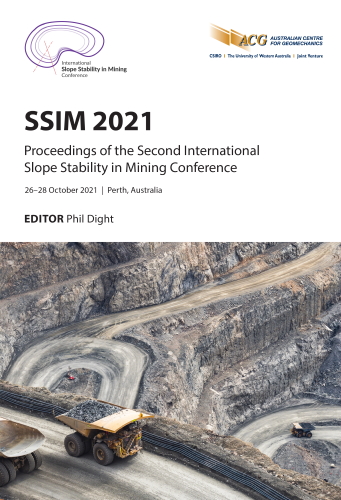Visualising bias of structural orientation data

|
Authors: Thomas, RDH |
DOI https://doi.org/10.36487/ACG_repo/2135_0.02
Cite As:
Thomas, RDH 2021, 'Visualising bias of structural orientation data', in PM Dight (ed.), SSIM 2021: Second International Slope Stability in Mining, Australian Centre for Geomechanics, Perth, pp. 11-26, https://doi.org/10.36487/ACG_repo/2135_0.02
Abstract:
Structural discontinuities represent an essential component of the geotechnical model for rock slope design. The bias associated with structural orientation data collected from different sources is reviewed, and existing methods of understanding and overcoming this bias are discussed. An alternative method of visualising the bias is presented. This method can be applied to single drillholes, datasets derived from multiple drillholes and scanlines, face mapping or combinations of multiple sources (e.g. a combination of drillholes and mapping data). The method provides a graphical presentation of the structural orientation bias within the selected dataset. The visualisation allows identification of areas of the stereonet in which discontinuities may be under-represented and enables consideration of potential methods to reduce the associated bias. The technique assists the geotechnical designer in understanding whether datasets selected for geotechnical analysis are representative and provides an opportunity to account for the bias.
Keywords: structural data, orientation bias, stereonets, Terzaghi correction, sampling weight
References:
BasRock 2021, Gem4D, version 1.8.4.7, computer software, https://www.basrock.net/gem4d
Brown, ET 2007, Block Caving Geomechanics, 2nd edn, Julius Kruttschnitt Mineral Research Centre, The University of Queensland, Indooroopilly.
Fillion, MH & Hadjigeorgiou, J 2018 ‘Quantifying the influence of geotechnical borehole inclination on collecting joint orientation data’, Mining Technology, vol. 127, no. 1, pp. 26–40.
Fowler, MJ 2013, ‘Structural data bias in the digital age’, in PM Dight (ed.), Slope 2013: Proceedings of the 2013 International Symposium on Slope Stability in Open Pit Mining and Civil Engineering, Australian Centre for Geomechanics, Perth, pp. 219225,
Laing, W 2005, ‘The data gap in geology and its implication for resource estimation’, Australian Institute of Geoscientists Bulletin, vol. 42, pp. 37–53.
Park, HJ & West, TR 2002, ‘Sampling bias of discontinuity orientation caused by linear sampling technique’, Engineering Geology, vol. 66, no. 1–2, pp. 99–110,
Priest, SD & Hudson, JA 1976, ‘Discontinuity spacings in rock’, International Journal of Rock Mechanics and Mining Sciences & Geomechanics Abstracts, vol. 13, no. 5, pp. 135–148.
Read, JRL & Stacey, PF 2009, Guidelines for Open Pit Slope Design, CSIRO Publishing, Australia.
Terzaghi, RD 1965, ‘Sources of error in joint surveys’, Geotechnique, vol. 15, pp. 287–304.
Wang, X & Mauldon, M 2006, ‘Proportional error of the Terzaghi correction factors’, Proceedings of the 41st US Rock Mechanics Symposium - ARMA’s Golden Rocks 2006 - 50 Years of Rock Mechanics, American Rock Mechanics Association, Golden.
Weir, FM 2012, ‘The future of structural data from boreholes’, in G Narsilio, A Arulrajah & J Kodikara (eds), Proceedings 11th Australia - New Zealand Conference on Geomechanics: Ground Engineering in a Changing World, Australian Geomechanical Society and New Zealand Geotechnical Society, Melbourne.
Wylie, DC & Mah, CW 2004, Rock Slope Engineering, Civil and Mining, 4th edn, Spon Press, London.
© Copyright 2025, Australian Centre for Geomechanics (ACG), The University of Western Australia. All rights reserved.
View copyright/legal information
Please direct any queries or error reports to repository-acg@uwa.edu.au
View copyright/legal information
Please direct any queries or error reports to repository-acg@uwa.edu.au